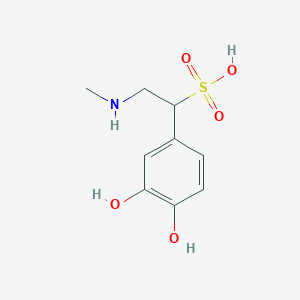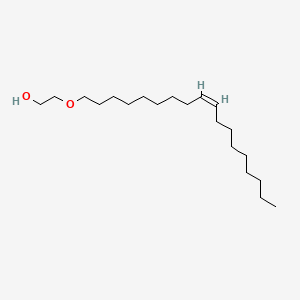
1-Azido-3-iodopropane
- Haga clic en CONSULTA RÁPIDA para recibir una cotización de nuestro equipo de expertos.
- Con productos de calidad a un precio COMPETITIVO, puede centrarse más en su investigación.
Descripción general
Descripción
1-Azido-3-iodopropane is a useful research compound. Its molecular formula is C3H6IN3 and its molecular weight is 211.00 g/mol. The purity is usually 95%.
BenchChem offers high-quality this compound suitable for many research applications. Different packaging options are available to accommodate customers' requirements. Please inquire for more information about this compound including the price, delivery time, and more detailed information at [email protected].
Aplicaciones Científicas De Investigación
Applications in Click Chemistry
Click chemistry refers to a set of powerful reactions that allow for the rapid and efficient formation of covalent bonds. 1-Azido-3-iodopropane is particularly useful in:
- Copper-Catalyzed Azide-Alkyne Cycloaddition (CuAAC) : This reaction involves the reaction of azides with terminal alkynes to form 1,2,3-triazoles. The use of this compound facilitates the synthesis of various triazole derivatives, which have applications ranging from drug development to materials science .
| Reaction Type | Description | Applications |
|---|---|---|
| CuAAC | Reaction between azides and alkynes | Drug synthesis, materials science |
| Strain-Promoted Azide-Alkyne Cycloaddition (SPAAC) | Copper-free alternative for biological applications | Bioconjugation in living systems |
Bioconjugation and Protein Labeling
This compound is employed for bioconjugation processes, particularly in labeling proteins with fluorescent tags. For instance, bovine serum albumin (BSA) can be modified with azide groups using this compound, allowing for subsequent labeling with fluorophores through click chemistry . This method is advantageous due to its specificity and efficiency.
Case Study: Fluorescent Labeling of Proteins
A study demonstrated the use of this compound to label BSA with fluorescent dyes. The process involved:
- Treating BSA with this compound in a TRIS buffer.
- Irradiating the mixture to facilitate the reaction.
- Analyzing the resulting fluorescently labeled protein using spectroscopic methods.
This technique highlights the potential for real-time imaging and tracking of proteins in biological systems .
Pharmaceutical Applications
The compound has been explored for its potential in developing new pharmaceuticals. Its ability to form stable triazole linkages makes it a candidate for synthesizing bioactive compounds.
Case Study: Antifungal Activity
Research has indicated that derivatives synthesized from this compound exhibit antifungal properties. A series of compounds were prepared through click chemistry involving this azide, leading to promising results against various fungal strains .
| Compound | Activity | Target Organisms |
|---|---|---|
| Triazole Derivative A | Moderate | Candida albicans |
| Triazole Derivative B | High | Aspergillus niger |
Material Science Applications
In material science, this compound is utilized for modifying surfaces and creating functional materials. Its reactivity allows for the incorporation of azide functionalities into polymers, which can then undergo click reactions to create crosslinked networks or functionalized surfaces.
Case Study: Surface Functionalization
A study demonstrated the functionalization of polymer surfaces with azide groups using this compound, followed by subsequent reactions with alkyne-functionalized compounds. This approach enabled the creation of bioactive surfaces suitable for tissue engineering applications .
Propiedades
Fórmula molecular |
C3H6IN3 |
|---|---|
Peso molecular |
211.00 g/mol |
Nombre IUPAC |
1-azido-3-iodopropane |
InChI |
InChI=1S/C3H6IN3/c4-2-1-3-6-7-5/h1-3H2 |
Clave InChI |
GTBCENNLSAZFSM-UHFFFAOYSA-N |
SMILES canónico |
C(CN=[N+]=[N-])CI |
Origen del producto |
United States |
Descargo de responsabilidad e información sobre productos de investigación in vitro
Tenga en cuenta que todos los artículos e información de productos presentados en BenchChem están destinados únicamente con fines informativos. Los productos disponibles para la compra en BenchChem están diseñados específicamente para estudios in vitro, que se realizan fuera de organismos vivos. Los estudios in vitro, derivados del término latino "in vidrio", involucran experimentos realizados en entornos de laboratorio controlados utilizando células o tejidos. Es importante tener en cuenta que estos productos no se clasifican como medicamentos y no han recibido la aprobación de la FDA para la prevención, tratamiento o cura de ninguna condición médica, dolencia o enfermedad. Debemos enfatizar que cualquier forma de introducción corporal de estos productos en humanos o animales está estrictamente prohibida por ley. Es esencial adherirse a estas pautas para garantizar el cumplimiento de los estándares legales y éticos en la investigación y experimentación.















